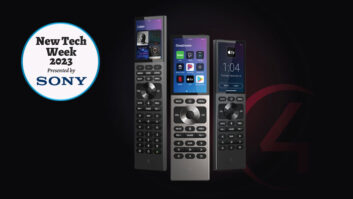When you consider that modern flat-panel TVs are less than two inches thick, feature bezels measured in millimeters, and have speakers on the back of the display firing away from the listener and into the wall, it’s no wonder they produce anemic audio with dialog that people have difficulty understanding. It’s also no surprise that soundbars are practically becoming a requisite add-on to most flat-panel sales. The limitation of most soundbars, however, is their anemic bass output. With small drivers fitting into thin cabinets designed to match the look of modern displays, they can’t produce any weighty bass info. And unless you like listening to everyone sounding slightly castrato, the solution is adding a subwoofer. But what if you are dealing with a homeowner that doesn’t want an extra black box sitting on the floor?

Paradigm’s Soundscape Powered Soundbar
The Soundscape, hailing from the Paradigm’s successful Monitor Series, is the company’s first foray into the 5.1-channel powered soundbar category. While Paradigm clearly borrowed some design cues from sister-company MartinLogan’s Motion Vision bar introduced in 2012, the principal difference is that the Soundscape uses Paradigm’s PAL anodized pure aluminum tweeters instead of MartinLogans’ Folded Motion high-frequency drivers, and features significantly more amplifier power. This additional power coupled with longer mid/bass driver excursion (and I’m sure additional Paradigm secret-sauce engineering prowess) allows the Soundscape to produce far more bass. So much so that when I first experienced the Soundscape during this past CES, I asked which sub they had it paired with. When Paradigm’s marketing manager, Erin Phillips, coyly smiled and said, “There’s no subwoofer; that’s just the bar,” I had to bring this in for review.
The bar installs like any other, coming with a wallmount bracket. (There is an integrated foot/ base if you want to set it on a tabletop or mantle, and an EQ setting accounts for either location.) There are multiple inputs, but I used a single Toslink optical from my TV, letting me hear audio from my Kaleidescape, DISH, and Control4 system. Soundscape decodes both Dolby Digital and DTS audio along with Paradigm’s proprietary Virtual Surround (which can be turned off). The bar features music and movie EQ modes, and the music mode definitely de-emphasizes the center channel, giving better stereo width, and less “locked to the speaker” sound. Besides increasing center-channel focus for dialog, movie mode emphasizes bass a bit–a feature I quite prefer.
While most owners likely won’t need a separate subwoofer, there are two ways to add one. First is a standard RCA output to a wired sub. Second is via the included wireless receiver from which Soundscape beams a signal up to 50-feet to any powered sub. I paired it with two different subs and it worked as promised, and, yes, an outboard sub did best what the bar could do on its own. When an external sub is connected, the bar adjusts crossover points ensuring a more seamless integration.
The bar can learn remote codes for all of its commands, letting you use your favorite third-party remote or a simple handheld. I had a minor issue with this where it wouldn’t ramp volume up or down with my DISH remote, instead only raising or lowering by click-click-clicking.
Sonically is where the Soundscape truly shines, however, keeping the often difficult-to-understand dialog from the opening ocean battle scene of Master and Commander centered and intelligible, while still producing the distant wind and atmospheric ocean sounds, giving nice width to the sonic image. Equally impressive was how the bar handled the deep bass and bombast of the cannon battle, producing rumblings I could feel and pushing the sounds of exploding cannon balls and splintering hulls well beyond the width of the bar.
The Soundscape demonstrated its ability to deliver weight and depth in reproducing the weighty voice and foot stomps of Smaug from The Hobbit: The Desolation of Smaug. It was amazing how the bar made Smaug’s voice boom and rumble around the room, seeming to come from nearly everywhere at once, producing a very real faux-surround effect.
I used the Get a Horse short from the beginning of Frozen to test the bar’s ability to produce a swirling sound image. Having watched this several times with my daughter on my reference nine-channel system, I know there are a lot of discrete effects as the plane flies around the back of the room. While the Soundscape couldn’t produce true rear-channel audio, it did a nice job of sonically transporting the plane around the room well beyond the speaker’s boundaries.
Another of Soundscape’s cool tricks is the inclusion of Bluetooth with AptX, including AVRCP (Audio/Video Remote Control profile) enabling the Soundscape to control–play/pause, skip forward/back–the source. This was a great way for me to beam audio from my iPhone5 and laptop to the bar, making it a potent second-zone audio system. I did find the Bluetooth range a bit more finicky than other products I’ve tested, so it is definitely best for near-field transmission.
While the Soundscape is pricey by soundbar standards, it certainly has the features and performance chops to back it up. And when clients hear how great it sounds without requiring an extra black box, they’ll likely consider it a bargain.
905.696.2868
paradigm.com
Kudos
Terrific sound and incredible bass without a sub; Bluetooth AptX streaming
Concerns
Bluetooth range a bit limited
Product Specs
• 7 x 50 watt (25 RM) power amplification
• Four 4-inch bass/mid drivers with 1-inch voice coil, three 1-inch pure aluminum tweeters
• Inputs: Optical digital (2), coaxial digital, RCA analog; Subwoofer line-level output
• Bluetooth aptX receiver with AVRCP for wireless streaming
• Includes wireless subwoofer receiver for adding subwoofer
• Decodes Dolby Digital and DTS surround formats
• Dimensions: (H x W x D): 5.5 x 42 x 5.5-inches; 20 pounds







